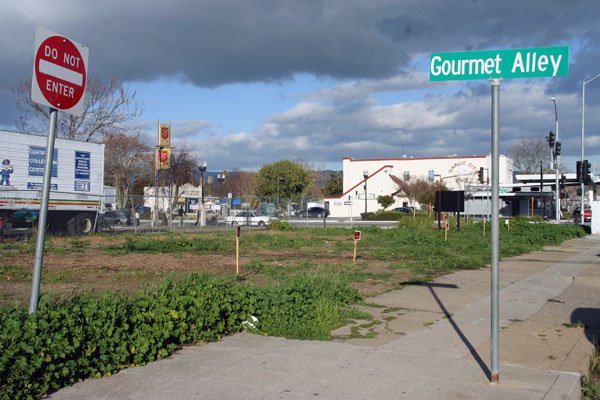One day residents could go to work, check out a book, buy a cup
of coffee, see a play and then go to bed all on the same piece of
property.
One day residents could go to work, check out a book, buy a cup of coffee, see a play and then go to bed all on the same piece of property.
Councilmembers considered this novel idea at a study session Wednesday night to cut down on the costs of an increasingly expensive downtown art center. Councilman Dion Bracco said if voters approve a $37 million bond for a new library, then that would free up $7.2 million in city funds slated for the project. That money could then augment the art center fund of $8.7 million, and the two projects could merge along with privately funded retail, office and living space. The city would save money hand over fist, but councilmembers cautioned that this new idea needs fleshing out before any serious consideration.
“I don’t know if it’s a good idea or a bad idea ultimately, but why not explore it?” Councilman Perry Woodward said. “I’m a little wary of aspects of the public-private partnership because we’ll give up a lot of control with that, but getting a nicer art center and a library as part of a joint project is a good idea.”
Mayor Al Pinheiro said, “I believe this community is going to stand behind a bond to fix the library (because) a library bond will help the arts group on the other side by freeing up money.” A recent survey showed that 64 percent of Gilroy voters support a library bond measure, but this is just shy of the required two-thirds support.
While they did not speak to the notion of an arts center-cum-library, about 20 artists showed up Wednesday night to cheer their cause, and they resoundingly approved an arts center with shops, office space and condos in the mix.
“The idea of bringing in office space that’s appropriate for the arts center is a wonderful idea. We would love to see that here and have it be multi-use in every way,” said Donna Pray, executive director of the Gilroy Foundation, which has fund-raised for the center with the Gilroy Arts Alliance. GAA President Carol Harris agreed and said she was not opposed to a mixed-use building either, and a handful of singers, musicians, teachers and painters also stood up to support the idea. Just get it done, they all said.
Such pragmatism is a good sign, said Mayor Al Pinheiro.
“I was very proud of the arts group because they were open to new ideas. The arts center does not have to be a stand-alone building. ‘We just need a building,’ they said, so it’s a win-win for both (the city and the artists).”
The mayor cautioned, though, that if the council combines a new library, scheduled for construction in 2015, with the arts center, scheduled for 2012, then it ought to be careful so “we don’t derail things by trying to do everything for everybody.”
“The plans for the library are ready to go, so to try to convolute that by combining it with the arts center (which has no building plans), that’s a question that needs to be answered,” Pinheiro said. “Let’s not get so off track now that we derail both of them.”
Building plans for the library call for a two-story, 54,000-square-foot building to replace the tired one-story structure there now, and Librarian Lani Yoshimura said she understands how joining the two appears appealing, but it might not work logistically.
“I’m not sure that would totally work. We have more than 1,000, and sometimes close to 1,800, people come in every day … Maybe the museum would be a better match,” Yoshimura said. She cautioned, however, that the county – which rents the city building for $1 per year and then provides the books and staff – would be better suited to comment on the matter, though county library officials could not be reached by press time Thursday.
Councilwoman Cat Tucker said she was passionate about both projects and did not want to compromise either one. Library aside, though, everyone seemed to embrace the union of the theater and capitalism.
Councilman Bob Dillon, who initially shirked at the idea of a retail-imbued arts center, changed his mind Wednesday night: “Anything to reduce operation and construction costs,” he said. This is the latest financial riddle for the council that voted last month to bond the purchase of Gilroy Gardens for $14 million; it is also considering another $10 million bond for sidewalk repairs.
Other ideas for realizing the 28,000-square-foot artistic haven at the northwest corner of Seventh and Monterey streets include renting the entertainment portion out for weddings and banquets, but council members and community leaders indicated that the retail component is key.
The mayor is not just guessing either. He spent Feb. 7 walking around the weed-covered lot with Community Services Director Susan Andrade-Wax and Economic Development Corporation President Larry Cope. The three strolled along with a small crowd of well-dressed developers, who corroborated the practicality of bridging art and commercialism, Pinheiro said. The mayor also pointed to other projects such as the Hale Center Theater in Orem, Utah, where a developer built the 500-seat theater along with residential, retail and office space, and then the city furnished and equipped the theater.
As vice president of AMS Planning & Research, Robert Bailey prepared much of the material the council considered Wednesday night, and he will continue to work with Andrade-Wax to craft a business plan for the center and report back to the council by March 17. The city hired AMS for $30,000 late last year.
Other cities with comparable theaters usually foot their operational costs, and Andrade-Wax has said those cities usually subsidize 30 to 40 percent of their operations, or about a few hundred-thousand dollars each year. Rohnert Park sells advertising on the city’s freeways to finance its center’s annual costs, Bailey added, and other cities have passed tax measures.
Bracco and other councilmembers have said it is important for Gilroy’s project to stand on its own financially, partly because the city does not have a redevelopment agency, unlike most cities with arts centers, according to Andrade-Wax. A redevelopment agency cannot fund ongoing operational costs, but it can redirect existing taxes from state into local coffers for specific capital projects such as sidewalk and street repairs, façade improvements and seismic retrofitting.
That is why the Gilroy Foundation and the GAA teamed up to raise $1.8 million – $1.5 million of which came from Don Christopher – for the center’s operational costs once the city builds it, according to Pray. Harris and other GAA members have said the group hopes for $3 million so it can earn enough interest to keep the center afloat without city money.
Fund-raising went on hold while AMS brain-stormed, though, because Pray said the foundation needs to know if there will be a design change that could affect their fund-raising efforts.














